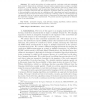Free Online Productivity Tools
i2Speak
i2Symbol
i2OCR
iTex2Img
iWeb2Print
iWeb2Shot
i2Type
iPdf2Split
iPdf2Merge
i2Bopomofo
i2Arabic
i2Style
i2Image
i2PDF
iLatex2Rtf
Sci2ools
SIAMAM
2011
2011
Imaging Schemes for Perfectly Conducting Cracks
We consider the problem of locating perfectly conducting cracks and estimating their geometric features from multi-static response matrix measurements at a single or multiple frequencies. A main objective is to design specific crack detection rules and to analyze their receiver operating characteristics and the associated signal-to-noise ratios. In this paper we introduce an analytic framework that uses asymptotic expansions which are uniform with respect to the wavelength-to-crack size ratio in combination with a hypothesis test based formulation to construct specific procedures for detection of perfectly conducting cracks. A central ingredient in our approach is the use of random matrix theory to characterize the signal space associated with the multi-static response matrix measurements. We present numerical experiments to illustrate some of our main findings. Key words. asymptotic imaging, crack detection, imaging algorithms, random matrices, measurement noise, hypothesis testing...
Crack Detection | Multi-static Response Matrix | Response Matrix Measurements | SIAMAM 2011 | Software Engineering |
| Added | 15 May 2011 |
| Updated | 15 May 2011 |
| Type | Journal |
| Year | 2011 |
| Where | SIAMAM |
| Authors | Habib Ammari, Josselin Garnier, Hyeonbae Kang, Won-Kwang Park, Knut Sølna |
Comments (0)

